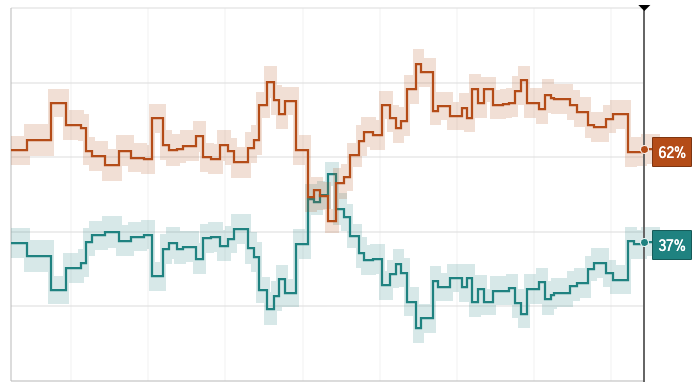Listen to the article
American public opinion remains deeply polarized on major issues as the 2024 election approaches, according to recent data from the Associated Press-NORC Center for Public Affairs Research.
President Joe Biden’s approval rating continues to hover around 40%, a figure that has remained relatively consistent throughout much of his presidency despite significant policy achievements. The stubborn approval numbers reflect the entrenched partisan divide in American politics, with Democrats largely supporting the president while Republicans remain overwhelmingly opposed.
Economic concerns dominate voter priorities, with inflation and the overall state of the economy ranking as top issues for many Americans. Despite positive economic indicators including steady job growth and moderating inflation, many voters still express pessimism about their financial situations and the nation’s economic direction.
The polls reveal a stark partisan split in how Americans view the economy. Republican voters consistently rate economic conditions more negatively under the Biden administration than Democratic voters, highlighting how political affiliation often shapes perceptions of objective economic metrics.
Immigration has emerged as another flashpoint, with border security generating significant voter concern. The Biden administration has struggled to balance humanitarian obligations with enforcement measures, leading to criticism from both sides of the political spectrum. Republicans have made border security a central campaign issue, while progressive Democrats have criticized some of the administration’s more restrictive policies.
Foreign policy challenges have also affected public opinion, particularly regarding U.S. support for Ukraine and Israel. The AP-NORC polling shows Americans divided on continued military aid to Ukraine in its conflict with Russia, with support gradually eroding as the war stretches into its third year. Similarly, U.S. policy toward the Israel-Hamas conflict has generated passionate disagreements, with different demographic groups expressing varying levels of support for each side.
Climate change remains another divisive issue, though the partisan gap appears to be narrowing slightly as extreme weather events become more common. The polls indicate growing concern about climate impacts across political affiliations, though significant disagreements persist about the appropriate policy responses and economic trade-offs.
On social issues, the polling reveals continued division on topics like abortion rights, gun control, and LGBTQ+ protections. Following the Supreme Court’s overturning of Roe v. Wade in 2022, abortion has become increasingly salient for Democratic voters in particular, while Republican voters are more likely to prioritize issues related to education policy and perceived threats to traditional values.
The AP-NORC data also highlights interesting demographic trends beyond party affiliation. Age appears increasingly correlated with political views, with younger voters more likely to support progressive positions on climate, social issues, and economic inequality. Regional divides remain significant as well, with urban and rural voters often occupying opposite ends of the opinion spectrum on multiple issues.
Trust in institutions continues its troubling decline, with Americans expressing low confidence in Congress, the media, and the Supreme Court. Only the military and scientific institutions maintain relatively high levels of public trust, though even these have seen some erosion in recent years.
Looking ahead to the 2024 election, the polling suggests a deeply divided electorate with few signs of convergence on major issues. Most voters report being firmly decided in their partisan preferences, with a relatively small proportion of true swing voters who might determine the outcome in closely contested states.
Political analysts note that these entrenched divisions make traditional campaigning—focused on persuading undecided voters—increasingly difficult. Instead, turnout and base mobilization may prove decisive in the upcoming election cycle.
The AP-NORC polling methodology involves surveying approximately 1,000 adults nationwide using probability-based sampling techniques. The polls typically have margins of error around plus or minus 4 percentage points, with variations depending on specific sample sizes and question formats.
As the campaign season intensifies, these polling trends will offer crucial context for understanding voter priorities and how candidates’ messages are resonating with different segments of the electorate.
Fact Checker
Verify the accuracy of this article using The Disinformation Commission analysis and real-time sources.




10 Comments
It’s noteworthy that despite positive economic indicators, many Americans still feel pessimistic about their financial situations and the country’s economic direction. This disconnect is an important dynamic to understand.
These poll results highlight the challenges of governing in a deeply divided country. Addressing voters’ economic concerns while navigating partisan divides will be crucial for the Biden administration and any future presidential candidates.
Absolutely. Bridging the partisan gap on economic issues will be critical, as perceptions often seem to be shaped more by political affiliation than objective data.
The stubborn approval ratings for President Biden reflect the polarized political landscape we’re operating in. It will be important to see if economic issues remain the top priority for voters as the 2024 campaign gets underway.
Agreed. The economy seems to be a key factor, but voter priorities can shift over time. It will be worth tracking how the public’s views evolve on economic conditions and the president’s performance.
The persistence of President Biden’s approval ratings, despite policy achievements, speaks to the entrenched nature of partisan divides in the US. Navigating these divides will be a key task for political leaders in the years ahead.
It’s interesting to see the continued partisan divide in how Americans view the economy and the president’s performance. Economic concerns like inflation seem to be a driving factor, even as some indicators show improvement. I wonder how these perceptions will shift as we approach the next election cycle.
The stark partisan split in how the economy is viewed is a fascinating aspect of these poll results. It underscores how political allegiance can color people’s perceptions of objective economic realities.
Agreed. This partisan divide in economic views is a crucial factor that will shape the political landscape leading up to the 2024 election.
These poll findings highlight the complexities of public opinion and the challenges facing policymakers in a polarized political environment. It will be important to monitor how these dynamics evolve in the coming years.